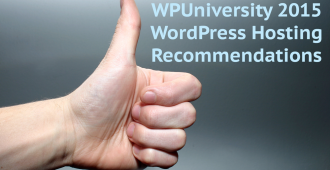
A new year means new beginnings, new opportunities, and new resolutions for making 2014 an even better year than 2013. Here are ten WordPress resolutions to help guide us through the next twelve months:
1. Be attentive.
In 2014, we should be focusing on user behaviour and technical performance.
Some tools to get us started off right:
Install Google Analytics and try these custom reports from Avinash Kaushik. This’ll give you a nice statistical overview of how your site is being used.
Set up Google & Bing webmaster tools. Bing provides some data that Google does not. Together, these two services show you how the search engines perceive your sites.
Use Jetpack Monitor, Monitor.Us, or Pingdom to monitor your site’s uptime. You’ll be alerted if your site goes down for whatever reason.
Use heatmap tools like Crazy Egg or ClickTale to visualize where users are actually clicking on your website. (Very useful for making layout changes, especially with ecommerce!)
2. Be lean.
Losing weight is probably the most popular new years resolution. Chances are your site could do with a bit of slimming-down, too.
We know that Google puts a lot of focus on load times. They’ve been talking about it since 2010. Now’s the time for us to put their advice into action:
- Check your site’s current performance using Google’s PageSpeed tools.
- Remove plugins that you’re not using.
- Install a caching plugin like W3 Total Cache or Super Cache.
- Compress your images, e.g. with JPEGmini.
- Jetpack’s Photon feature loads your images from the WordPress.com CDN.
- Use a CDN like Cloudflare or MaxCDN.
- Get better web hosting, e.g. from WP Engine.
3. Be secure.
WordPress is a juicy target for hackers because it powers over 20% of websites globally. While the core WordPress software is very secure, exploits can be introduced after the install, through users (e.g. guessed passwords), plugins, and themes.
Stay safe in 2014 by educating yourself and installing a good security plugin:
- Hardening WordPress (Codex)
- Definitive Guide to WordPress Security (Moz)
- Sucuri Plugin for WordPress
- Plugins: Wordfence & Better WP Security
4. Back your stuff up.
Once is never enough. You should, ideally, have your site files and database backed up in at least two locations, just in case something happens to the files stored in one location. Drobo has a good article on this subject.
You can achieve this with the help of a backup plugin like Backup Buddy from iThemes, UpdraftPlus, or BackWPup. Have two backup locations: one on your web host (FTP), and one remote (e.g. Dropbox). Lastly, consider having offline backups on your computer, or on an external hard drive or USB key.
5. Stay updated.
You’ve heard it before, but we’ll be saying it over and over again until the sun stops rising in the east: keep WordPress updated. This includes your plugins and themes!
If you don’t update, you’re missing out on the performance improvements, security fixes, feature upgrades, and other nice-to-haves that come with updates.
For extra diligence, you can check update compatibility and performance by mirroring your websites in a staging environment.
Some hosting providers, like WP Engine and SiteGround, have one-click mirroring built in. Alternatively, you can take a DIY approach using a plugin like WP Migrate DB.
6. Test for multiple devices.
We have a wide range of screen sizes these days: Smartphones (4”), tablets (7”-10”), laptops (10”-15”), desktops (20”-30”), and large displays, like televisions (30”-50”). How does your site look and behave in these environments?
If you don’t have suitable testing devices on-hand, you can use a browser emulator service or desktop software instead. Some useful tools we’we’ve worked with include:
- BrowserStack (Paid)
- Keynote MITE (Free)
- Keynote Device Anywhere (Free)
In addition to the various device dimensions, we also have high-density pixel displays (e.g. Retina Display on Apple products) that add to the complexity. Sites that have been built with these displays in mind will be more visually appealing to visitors.
7. Care about accessibility.
With all this talk of visuals, it’s easy to forget about those with vision problems, including people who use assistive technology like screenreaders to navigate the web.
In 2014, we should make our websites more usable for people and machines alike by paying attention to accessibility and inclusive design. By doing so, we not only make our sites more usable for people, but we also make them more “digestible” for search engines.
Resources to help you get started:
- Fast Secure Contact Forms Plugin
- WP-Accessibility Plugin
- Make WordPress Accessible
- Web Accessibility Resources from WebAIM
8. Plan ahead.
Procrastination is junk food for the mind. We know they’re not good, but they’re easy and provide some short-term satisfaction, albeit at the expense of added stress later on.
Let’s make 2014 the year when we stop kicking the can down the road. Let’s break up those big, hairy, audacious goals into smaller objectives using a combination of actionable task lists (so we’re not keeping things in our head) and calendars (so everything has a due date).
- For task lists and ideas: We use Trello at the office, and I use Todoist for my personal projects. Prefer long-form notes? Check out Google Keep, Evernote, or Simplenote.
- For scheduling: A simple shared calendar will do. For more functionality, try out Edit Flow or CoSchedule, both of which are geared to publishing teams.
9. Support a cause.
I find that we often get caught up in the commercial side of things, whether it be using WordPress to build a business website or monetizing a hobby site to generate revenue.
But there’s so much more that we can do.
In 2014, let’s find ways to support worthwhile causes using WordPress. Consider volunteering your time and skills. What can you contribute to local community groups? Fundraisers?
For novice WordPress site builders this is a great way to network, build a portfolio, and get some experience under your belt.
10. Get involved.
The global WordPress community is massive, active, and passionate about what they do. If you’ve been working with WordPress — or even just playing with WordPress — you should join in! There are a number of ways to get involved:
- Join a local WordPress meetup.
- Join an online WordPress community: Google+, Facebook, LinkedIn
- Attend, speak, or volunteer at a WordCamp.
If you’re looking to do more, and have the tech chops for it:
- Help people in the support forums or on IRC.
- Join a Make WordPress working group.
What else can we do for 2014?
What WordPress resolutions do you have for 2014? Share them in the comments below, or create a post and link back here. We’ll add it to this post. 🙂
